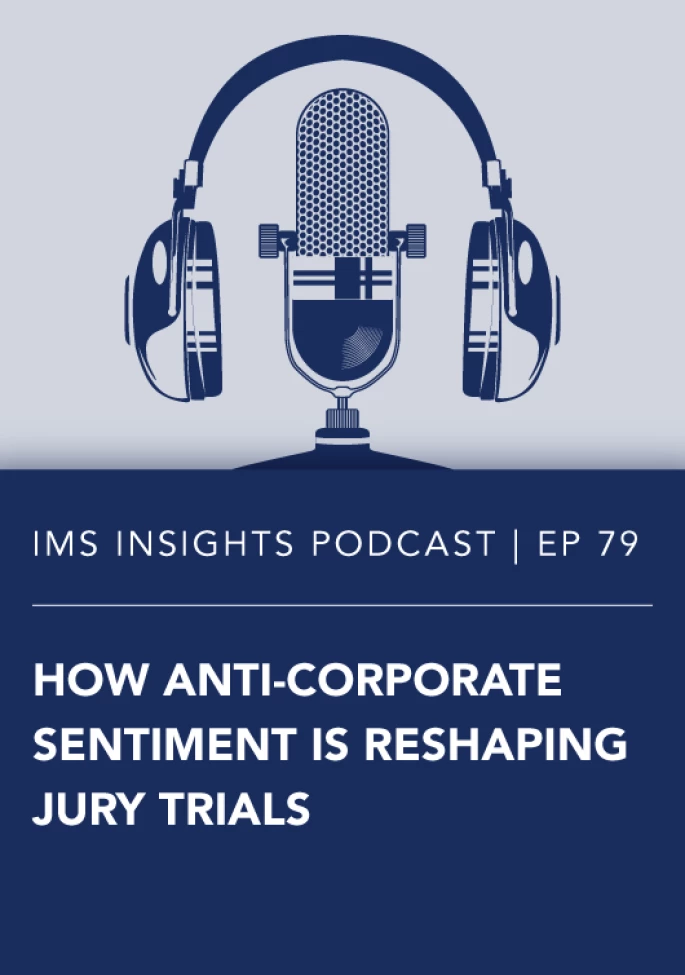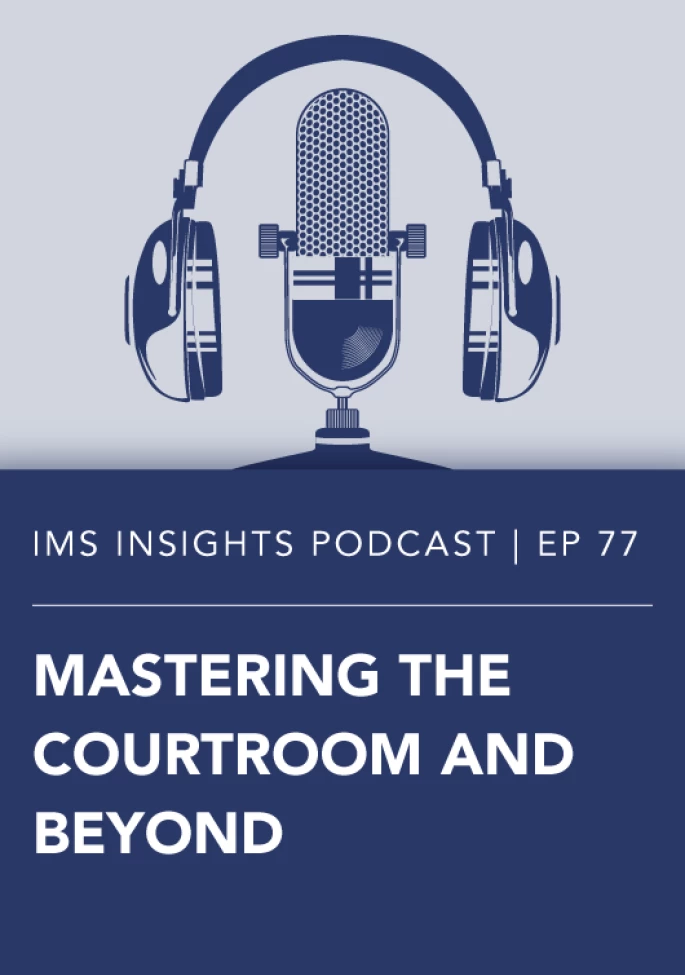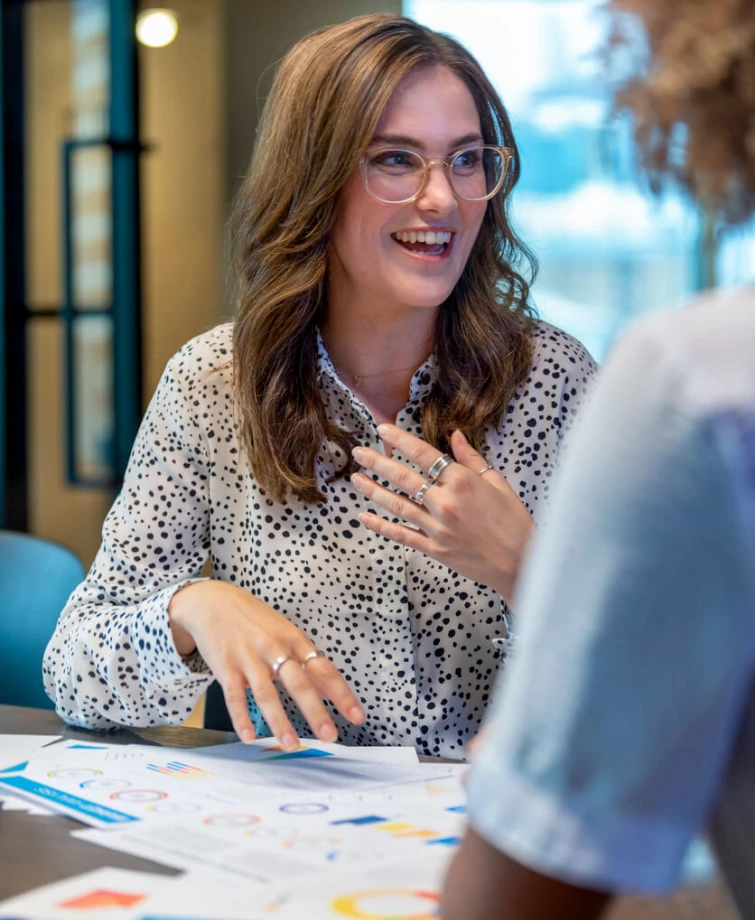Adam Bloomberg (Intro): Welcome to the IMS Insights Podcast, where the nation’s leading experts in litigation trends share their insights.
Today, we're speaking with Jason Barnes, Senior Strategy Advisor and an Emeritus here at IMS. With more than 30 years of experience, Jason has developed case strategies for countless arbitrations and trials for law firms and corporations nationwide. He possesses significant knowledge on how to simplify complex concepts, early case strategy, and his work with expert witnesses. He has extensive experience in the Eastern District of Texas, the International Trade Commission, and state courts throughout the country. Leading the discussion is our very own Chris Dominic, Senior Strategy and Jury Consulting Advisor here at IMS. Chris, over to you.
Chris Dominic: Thanks, Adam. Jason, how you doing?
Jason Barnes: I'm all right. How about yourself?
Chris Dominic: Good, good. I've been really looking forward to this. I'm not sure if I've actually ever asked you before, how did you get into this in the first place?
Jason Barnes: Oh, in 1998, I opened my company, Barnes and Roberts, and in 1999, we were hired by Jones Day to go to a patent case in Marshall, TX, which was Texas Instruments versus Hyundai. It became the Seminole case, the thing that started the IP revolution in the Eastern District of Texas. Now, as a result of that, I did a lot of work in the Eastern District and a lot of patent work that followed on with that, because it's really right in my backyard.
Chris Dominic: Yeah, absolutely. What have you been working on lately?
Jason Barnes: Well, and still a large part of my caseload is intellectual property, which I really enjoy working on. It's right up my alley. But these days I do bank and trust cases. I do general commercial cases, antitrust. I have still a couple of IP cases, but even white-collar crime is a thing that I found myself doing more and more of.
Chris Dominic: So, you're still chalking up the airline miles is what I'm hearing.
Jason Barnes: I have a few airline miles this year. That's certainly true.
Chris Dominic: One of the things you and I work on and have a real passion for is early case strategy work, real strategic orientation. I'd love to hear some of your thoughts about what your passion is in that area right now.
Jason Barnes: Well, in terms of early case strategy, I like to, regardless of the case type, I like to look at a case and answer a few basic questions really is, are we able to tell a story that satisfies the head, the heart and the gut? And what I mean by that is how do we win on the facts and the law? That's how we talk to people who make decisions based on sort of their head. Is this fair? Why should I care, right? These are questions that I would ask about, you know, to help satisfy people who make decisions, maybe a bit more on empathy and things like emotionally based people. And then there's a story we're telling. Does it pass the smell test? Does it satisfy your need to understand the world, like common sense, right? Does this meet the requirements of common sense? Does it comport with how I experience life in the real world?
Chris Dominic: Right. And so, you need to address all three of those things.
Jason Barnes: Yeah. You know, it's funny. I was working on a job recently with one of your colleagues and we were doing an opening statement preparation together. And one of the things I said was this is a place where we should have no demonstrative specifically. And one of the things that made me really happy was we hadn't even talked about this in advance. I said this is a place where I want the jury's eyes to go to the attorney because this is a speech right now, and this is an important moment. And I look over at your colleague and they just look at me like, yeah, like, you know, it's not like they just want to put more graphics in all the time, right? We're both on the same page about what we're trying to do. We want that message to come across as best as it possibly can. I know you do a lot of opening work.
Chris Dominic: I do. And it's important to remember that even though we call ourselves visual advocates, not everything we do is visual, right? It's a lot about the stagecraft and the thing you were describing. It's about making sure where the focus is at any one time during an open statement or during a witness examination, right? For in some moments it's important that there's nothing on the screen. There's nothing to distract the jury. There's nothing to explain. You only want eyes on the attorney. Then you're going to say, look at this piece of evidence. Then you're going to say, follow along on this timeline with me. But when you're done with that, you want the eyes back, right? And that's so important to think about where people are, what they're thinking about, how they're perceiving this presentation that you're giving them.
Chris Dominic: Yeah. You know, when we were talking earlier about our approaches, I remember thinking we were talking about like what people say to us when we're, we ask them, why aren't we doing work earlier? And what I've heard some people say is when they, when they don't understand why I want to work earlier in the case, they'll say, well, you know, we haven't even really gotten that far into discovery yet. And my answer a lot of times is, well, I want to make sure that we have an idea of what our story is at least preliminarily for the witness preparation session. I know with you, a lot of times it's going to be, how are we going to make sure that these expert demonstratives make sense? Can you talk a little bit about experts and the way that works?
Jason Barnes: So I do like to get involved earlier than later. And if someone says, oh, well, we're really not that far along. And my answer is great. There's an opportunity to do some good work, right? And I, you know, in terms of visual advocacy, of course, there's always an opportunity to talk about thematic development, right? Hooks that you can insert either during your deponents presentation, safe harbors that they can go to, but there's also hooks that you can get when you're taking depositions from the other person to get them to admit things in just the right way. So there's always a good opportunity to talk about that kind of strategy. But when it comes to the visuals, a lot of times we work with the expert witness in terms of their expert report to make sure that the charts and graphs and diagrams, photographs and videos of them capturing evidence as they're doing testing, for example, this. We want to be consulted on the best way of capturing this evidence so that it's useful not only to report but also later at trial or to mediation, arbitration, things like that. We also are available so that you sometimes you want to take a deposition of your own expert or sometimes you want to challenge the other fellows expert with some kind of graphics. It's very difficult for them to do. So, we'll work on generating those graphics and figure out a way to present those a deposition also to be captured in the part of the deposition so that later on it can be used against them, you know, to get some admissions out of these people. So, it's never too early to start thinking visually. Also, I would just say this, if you can visualize it, if you can draw it, you can explain it. I always say to find that until I can draw it for you, I don't understand it, right. So visual thinking for me is just would have been inherent part of the way I process the world. So, for me, it's always good to think visually.
Chris Dominic: I saw something as I was walking through the office and I told myself, I had to ask you about it because I think, I think this is one of those things, you might need to hold this up for the camera at some point. This is one of those elements that I get so excited about. It is, is another different way to keep people's attention. It's another way to explain something. It's another way to take the experts and allow them to take something that's difficult or complex, simplify it for people. So can you give me the story behind this?
Jason Barnes: Sure. Let me set the stage a little bit more generally when we talk about expert testimony, Working with experts is an amazing and satisfying part of my career. They're so smart and one of the best parts about my long career is having met some of the smartest people literally on the planet. And I love doing that. But their superpower is also their greatest weakness, right? I mean, and so they're used to teaching PhD candidates and writing for people that are at the same level of expertise or maybe just below where they are. And so they're caught in that deal. So we always want to talk to them about how they're going to reach the jurors, how they're going to reach the court as well, right? They have to satisfy the other expert and lawyer, you know, so that they are like during cross examination, the things they said hold up, right. They have to be scrupulously accurate in a technical sense. They have to be able to persuade the court at some level that they're credible and they have expertise. But more importantly than that, they have to be able to reach jurors where they are, right. It's at least three audiences. And so, so it's very important that we're working with experts to prepare them for their testimony, that we consider their strengths, their natural proclivities. Are they good at teaching? Are they nervous teachers? Maybe we want to keep them in the chair, or maybe we want to get them out of the chair and let them teach. Can they draw on a whiteboard or a flip chart? Should someone else draw for them? Should we practice that, which I've done a number of times, teach people how to draw. It's not that hard. I can totally do it. Should we give them a, can they demonstrate a product, right? Can they show like is if it's software, maybe there's a prior art software? Can we boot up a computer and show it to people? In this case, we were talking about a device that was, you know, on the order of about an eighth of an inch square cubed. It was very small. We had diagrams and photographs and all kinds of evidence, but we wanted the expert to get up out of his chair and teach, because we know that when you stand up and teach the jury, there's a moment created between the jury and the expert or the lawyer if you're in that mode, right? And so we wanted to, you know, it's interesting the courtroom shrinks, right? So everybody else kind of disappears. It's only the person standing up there in front of them. We wanted to be our experts. Absolutely. Sometimes we like to give an expert a prop. In this case, because the device was so small, we use 3D printing, which at the time was quite new to enlarge this device. I think just make sure you get the camera there. There we go. OK, there we go to enlarge this device so that we could explain to the jury. Now, I'm not going to explain the technical details of what's going on in here, but essentially this is, you can think of it is it looks a lot like an integrated circuit. It's not. There's two magnets to cores, right? So there's cylinder shaped magnets, ring shaped magnets. Electricity comes in one side, creates a magnetic field which induces current on the other side. So the signal comes in and the signal goes out, and yet the electricity from here never touches the electricity on the inside. So the outward side world is disconnected anyway from the inside world so that you avoid electrical overload. Now, this is the super simplistic version, but that's what it was. We created two of these models, identical, one for the expert to hold and to teach to and one to publish to the jury. So we've passed it out to the jurors so they can hold it in their hands. It's a tactile. They could feel it. It was real to them. They can pass it one person to the next. They were making eye contact with one another, and there was a little sort of chatter. And, I mean, not improper chatter, but, you know, they were, you know, kind of passing it one to the next. It was a social event in that moment. It was a great 10 to 15 minutes of trial that would be very difficult to forget.
Chris Dominic: Yeah. Oh, absolutely. You know, that gets me thinking about because it's so much fun for us to work together on these sorts of things. I was thinking about the time you and I talked about what we really think is our superpower, right, which is this idea of we've got this big team. And when we get everybody working and we integrate with the trial team and we're all basically strategic partners working together, we can just do these really amazing things. Can you speak a little bit in your own words about some of that?
Jason Barnes: Well, you know, of course I said, you know, it was my idea, it was my idea, but I'm not the only person who did this, right? It takes a whole team to think about the question, consider every part of it, and then to put it into action. So, I like to think of this as a bit like eye-hand coordination. So when you and I work on a case where I work on it with any like a jury consulting person and a trial consultant or visual advocacy person, you may have a great vision, I might have great dexterity, but without coordination to put those things together, the eye-hand coordination, nothing gets done right. And it's not only true that we have to coordinate among our own teams within IMS, which brings a lot of capability and experience and power along with it. You know, there's a second part of integration that I think is ultimately more important and that is the integration with our attorney team, right, that they've called us in to ask that and we need to be available. We want to put all our skill sets, all of our experience when needed, as needed, right? And that means early in the case, we talked about developing strategies for discovery, working with witnesses to prepare them for deposition, working with experts to get their expert reports not just done and on time, but full of things that are persuasive, right? For example, besides that, it's like when you your extra report is super important when you have a summary judgment motion, your depositions in summary judgment, your summary judgment motion is really based on deposition testimony and expert reports, right? So, you want to make sure both of those things are done correctly from the get-go, right? So early stuff is important. So the early part, the middle part for testing, for jury research, of course, the jury consultants are important, but you want to put your best foot forward to get all of the visual advocacy you can and to imagine what the other side might also bring to the table to make sure that you were having a fair test, right, a fair fight, not only intellectually based on the facts of the law, all that stuff, but to put the visual advocacy fight also head to head as well. Get all that done. Plus, it's a great dry run in a way for your slides and your animations and all that stuff to have a testing people like them, but they effective what we do different. We're going to carry all that forward into the trial. So, it's important that we're there throughout that entire time to do our best work. It's the greatest opportunity to have the most persuasive product that you can get out of consultants like IMS.
Chris Dominic: See, I knew you were going to say that better than I do. So, Jason, thank you so much for being here today and for speaking with me about this. I really appreciate it. And Adam, it's all yours now.
Adam Bloomberg (Outro): IMS has served trusted law firms and corporations worldwide for more than 30 years and over 65,000 cases. As a strategic partner for the full case life cycle, our integrated teams provide specialized advisory support, expert witness services, litigation consulting, visual advocacy, and presentation technology to elevate strategies and protect hard-earned reputations. Learn more at imslegal.com.








